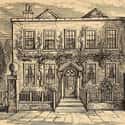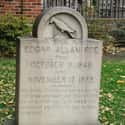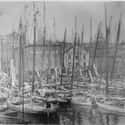-
(#1) Poe Was An Orphan By Age Two
Edgar Allan Poe was born in Boston on January 19, 1809. His parents, David and Eliza, were stage actors who lived a transient life along the East Coast. In the summer of 1809, Poe, his parents, and his older brother, Henry, relocated to New York City. Six weeks later, David Poe, an alcoholic, abandoned the family. Eliza then moved to Richmond, VA to work in the theater but quickly contracted tuberculosis and died on December 8, 1811.
Although the exact date is speculative, it is believed that David Poe died three days later in Norfolk, VA. Eliza had given birth to a daughter, Rosalie, in December 1810. Upon Eliza's death, her three children were split up. Henry went to live with grandparents in Baltimore, and Rosalie and Edgar went to two different families in Richmond, VA.
-
(#2) Poe's Relationship With His Guardian Was Terribly Dysfunctional
Edgar Allan Poe was taken in by John and Frances Allan, longtime residents of Richmond, VA. This is where the "Allan" in Edgar Allan Poe comes from. John Allan was a modestly prosperous merchant until 1825 when an inheritance from his uncle made him quite wealthy. Nevertheless, he considered himself a self-made man who had become successful without much formal education. His relationship with his ward was already stormy during Poe's adolescence. Allan wrote to Edgar's brother in 1824,
...why I have put up so long with his conduct is little less wonderful. The boy possesses not a Spark of affection for us not a particle of gratitude for all my care and kindness towards him. I have given him a much superior Education than ever I received myself.
The relationship became openly hostile when Poe enrolled at the University of Virginia. Allan provided only a small portion of the funds needed for Poe to attend school. When he ran out of money, Poe attempted to win it by gambling on card playing, but he lost and quickly ran up a $2,000 debt. Evidently, some of Poe's creditors approached John Allan for payment directly, but he refused to pay and yanked the undergraduate out of school in only his second semester. When Allan then demanded that Poe work for nothing at his trading firm, Poe left the household and moved to Boston with dreams of becoming a poet.
-

(#3) Poe's Only Occupational Success Was In the Army
Like many enterprises involving Edgar Allan Poe, his plan to move to Boston and become a successful poet was unrealistic and underfunded. The 18-year-old did self-publish a pamphlet of poetry entitled Tamerlane and Other Stories, but it went nowhere and merely exhausted whatever money Poe had. With no education or marketable skills, Poe's only solution, again made more out of desperation, was to enlist in the Army, which he did in May 1827.
He used the alias "Edgar A. Perry" so that neither John Allan nor his creditors from Virginia would know where he was. Surprisingly, Poe flourished in the Army. He served in three locations, including Fort Moultrie, SC, eventually one of the settings for the short story "The Gold Bug." He was considered reliable, competent enough to handle bureaucratic record-keeping and was quickly promoted to the rank of Sergeant-Major.
-
(#4) 'Tamerlane' Is Now The Holy Grail Of Rare American Books
Edgar Allan Poe's first attempt at literary success was Tamerlane and Other Poems a self-published pamphlet he released in 1827. Again, to retain his anonymity in Boston, he assumed the pseudonym "A Bostonian." The publisher, Calvin Thomas, typically printed handbills and apothecary labels. Tamerlane and Other Poems received no formal distribution, was not formally reviewed, and quickly disappeared. Even Poe's initial literary executor, Rufus Griswold, publicly doubted that the book even existed until a copy was found in the British Museum in 1876.
Of the approximately fifty copies originally printed, only twelve are known to exist today. Francis Wahlgren, a rare books specialist, told The Baltimore Sun it could be considered "the Holy Grail of 19th-century American literature." Christie's auctioned off a copy in 2009 for $662,500, breaking the previous record for the American literature genre by over $400,000. The previous record holder? Another copy of Tamerlane.
-
(#5) Poe Attended West Point, But Got Himself Kicked Out On Purpose
Despite finding a home and some degree of stability in the Army, Poe started to become bored and frustrated after only two years of a five-year mandatory hitch. He came up with the idea of leaving the Army and attending the US Military Academy at West Point. His commanding officer was sympathetic but would only help Poe if he reconciled with his adoptive father, John Allen, from whom he was estranged. The officer actually wrote to Allan, explaining Edgar's current circumstances and requested he reunite with his ward. But, in a typical display of indifference, Allan curtly replied that Edgar should stay right where he was and finish out his enlistment, which also ensured that Poe wasn't his problem, at least for the next three years. Only the death of Allan's wife in 1829, and Poe's attendance at the mutually beloved woman's funeral, caused Allan to grudgingly help Poe get into West Point.
Based on glowing reference letters from his commanding officers and by providing a replacement to finish out his enlistment, Poe was able to secure an appointment to West Point which formally began July 1, 1830. Predictably, Poe was unhappy as a cadet and, after a reasonably solid first semester, attempted to deliberately get expelled. He got his wish after being court-martialed on February 8, 1831, and convicted of dereliction of duty, not - as an urban legend has it - for showing up for drill in the nude.
-
(#6) Poe Was Disowned
When John Allan got word from the Army that Edgar had secretly been an enlisted man for two years, he was angered and appalled. Such a development was not only a degrading step for any member of upper-class society, it also reflected poorly on Allan, who may have been perceived as forcing such an act of desperation. Allan refused to speak to Poe at first but reconciled with him at his wife's funeral. But one incident would permanently sever their tenuous relationship.
Poe had agreed to pay a certain Sergeant Samuel Graves, to would serve out the rest of Poe's enlistment in the military so he could attend West Point instead. When it came time to pay up, Poe gave him the runaround and eventually suggested that he would try to get money from his guardian, John Allan, but that this would take longer because "Mr. Allan is not very often sober."
In 1830, Graves personally confronted Allan and showed him the letter. The debt was paid off and Allan subsequently refused to answer any of Poe's missives, no matter how desperate or apologetic. Allan got remarried to the mother of his two illegitimate children and fathered his own legitimate son and heir.
Poe never gave up on some sort of reconciliation, though. In 1834, when he heard Allan was on his deathbed, Poe visited his home, forced his way past Allan's wife, and entered his guardian's bedroom. As he approached Allan's bedside, Allan threatened to beat him with his cane and ordered him out of his sight. Poe was not even mentioned in John Allan's will.
-
(#7) Poe Married His 13-Year-Old First Cousin When He Was 27
When Poe got kicked out of West Point, he moved to Baltimore and into the home of Maria Clemm, his aunt and sister of his deceased father, David Poe. This household consisted of Poe, his aunt Maria, his aunt's mother, Elizabeth, and his aunt's young children, Henry and Virginia. While the family was almost as destitute as Poe, they did have Elizabeth's pension from the state of Maryland to keep a roof over the extended family's head.
Despite the difficult circumstances, Maria was quite supportive of Poe's literary career and referred to him as "Eddy." Poe also became fond of Virginia, but the exact nature of the relationship is still a matter of historical dispute. In August 1835, Poe left Baltimore for Richmond and a job with the Southern Literary Messenger. He promised that he would send for Maria and Virginia (Elizabeth and Henry had both died by 1835) as soon as financially possible.
Poe's employment prompted the Clemms' move to Richmond, and on May 16, 1836, Edgar Allan Poe married his 13-year-old first cousin. The debate over how normal this relationship was has ranged from it being consummated at the age of sixteen to the assertion that Virginia Clemm died a virgin.
-
(#8) Poe Had Serious Substance Abuse Issues
Edgar Allan Poe was not your typical substance abuser. He would frequently remain abstinent for months or even years. This stemmed from his inability to control his drinking once he got started. T. H. White, the first editor to hire him at the Southern Literary Messenger had to fire Poe over his drinking relatively soon after hiring him. He was so enthusiastic over Poe's ability when he wasn't drinking that he agreed to rehire him in October, 1836 if he could stay sober; Poe resigned under duress in January, 1837. Even in college, classmates remembered that Poe "would seize a full glass, without water or sugar, and send it home at a single gulp. This frequently used him up; but if not, he rarely returned to the charge.”
A close friend, Thomas Dunn English, observed Poe in 1839 literally in the streets of New York:
I was passing along the street one night on my way homeward, when I saw some one struggling in a vain attempt to raise himself from the gutter...To my utter astonishment I found it was Poe...Three days after when I saw Poe, for if I remember rightly the next two days he was not at the office, he was heartily ashamed of the matter, and said that it was an unusual thing with him, and would never occur again.
Unfortunately, as his life became more difficult, Poe's binge drinking became more serious and was the main catalyst to his mysterious death in 1849.
-
(#9) 'The Raven' Made Poe An Overnight Sensation But Still Left Him Broke
"The Raven," a narrative poem by Edgar Allan Poe, first appeared in January 1845. This tale of a man despondent over a lost love and his perhaps imagined bizarre interaction with a remarkable creature brought Poe worldwide popularity. Poe had built a solid reputation as a critic and his fiction was modestly successful, but this poem made him a literary celebrity. "
"The Raven" was republished in numerous newspapers and anthologies and caused the publication of two separate volumes of Poe prose and poetry. Children would follow him on the street shouting the word "Nevermore," and for the first time, Poe was welcomed into the most exclusive salons of New York society.
Although it brought fame, Poe was paid no more than $15 for the poem and possibly only $9. He earned $120 in royalties for the newly published editions but got nothing after borrowing $135 as an advance. In the entire year of 1845, he earned approximately $550, and of that, he owed $150 to individuals who lent him money to buy out his two partners at the Broadway Journal in October 1845. Poe believed he could make the publication profitable if he ran it himself. The journal was out of business by January 1846 and Poe was now not only broke, he was unemployed. He would never obtain another salaried position again.
-
(#10) Poe Lived With His Mother-In-Law Even After His Wife's Death
Because of mediocre performances during numerous paid lectures, attacks on powerful establishment figures like Emerson and Longfellow, and a scandal involving a married woman, in May 1846, Poe, his wife Virginia, and his wife's mother, Maria, relocated to virtual literary exile by moving to a rural cottage in the Bronx, fourteen miles from central New York City. Whatever momentum he generated with "The Raven" was now gone and his wife was already seriously ill with tuberculosis.
Virginia Clemm Poe died on January 30, 1847, aged 24. On her deathbed, she got her mother to promise that she would look after "Eddy," a promise that Maria kept for the rest of Poe's life.
-
(#11) Poe Proposed To Two Different Women In The Last Year Of His Life
Once Poe's wife died, Poe seems to have become determined to lift himself out of poverty by marrying into wealth or at least respectability. After exchanging letters and poetry for months with a widowed writer and poet named Sarah Helen Whitman, in September 1848, Poe abruptly showed up at her Providence, RI, home, declared his eternal love and forcefully proposed an immediate marriage. He returned to the Bronx where he received her letter of rejection but he journeyed to Providence again in October, reiterating his proposal. He then left for Lowell, MA, and the home of the family of Annie Richmond, another love interest who also happen to be married.
Poe would return to Sarah Whitman's home several times in November and December, actually getting her to agree to a Christmas Day wedding. The hostility of Sarah's mother, who legally placed the family estate out of any potential reach of Edgar, and Poe's drinking, despite a vow of abstinence, ultimately scuttled the relationship. Unbeknownst to Whitman, Poe was also romancing another woman, Sarah Royster Shelton, an old flame from Poe's childhood. In Richmond in 1848, attempting to raise money for a journal he would edit, Poe showed up at Shelton's house unannounced, the two having not seen each other since they were teenagers.
Poe spent much of the first half of 1849 in Virginia on lecture tours and attempted fundraising for his proposed journal and romancing Shelton, again proposing marriage continuously. Despite Sarah's children's objection and her deceased husband's will calling for a three-quarter forfeit of his estate in the event of remarriage, Sarah told Edgar she'd think it over while, in September 1849, he went to New York. She found out about Poe's October 7, 1849, death by reading about it in the newspaper.
-

(#12) The Details Of Poe's Death Remain A Mystery
Edgar Allan Poe boarded a steamboat in Richmond, VA on September 27, 1849, bound for New York City. In an attempt to win the hand of his latest intended bride, Sarah Royster Shelton, Poe had sworn a vow of abstinence. Most likely, Poe broke this vow of abstinence when the ship arrived at a scheduled stop in Baltimore on September 28, 1849.
It was not until October 3 that an individual named Joseph Walker sent a letter to an acquaintance of Poe's, Dr. Joseph Snodgrass, stating that Poe was found in a Baltimore gutter incoherent and needed help. When Snodgrass arrived on the scene outside of a local tavern, he took one look at Poe's vacant eyes and totally unkempt condition and immediately got him admitted to a hospital. Poe lingered for four days before dying on October 7, 1849. He remained incoherent and was never able to explain his circumstances to his attending physician, Dr. John Moran, the only person to interact with him in the confined area where Poe died.
Unfortunately, Moran only added to the confusion of Poe's last days by giving numerous paid, dramatic lectures and newspaper accounts with varying descriptions, all of them quite histrionic and unbelievable. The cause of Poe's death has historically ranged from rabies to a fatal beating inflicted by Sarah Royster Shelton's two brothers who had followed him to Baltimore. It is fitting that the inventor of the modern detective mystery story died himself under circumstances that still remain mysterious.
-
(#13) His Literary Executor Deliberately Destroyed Poe's Legacy
The shocking news that Edgar Allan Poe had died prompted a then-prominent critic to attempt to avenge a long-standing grudge. Rufus Griswold wrote a prominent, anonymous obituary in a major New York newspaper that began: "Word of Poe’s death will startle many, but few will be grieved by it." It only got worse from there. He skewered Poe as a man who wandered the streets either in "madness or melancholy" mumbling and cursing to himself because of intoxication and also a cad who conducted all sorts of scandalous liaisons, even while married.
As a critic, Poe had scathingly ridiculed Griswold and his successful poetry anthologies, but they also had periods of professional accord and Griswold even lent Poe money at one point. Clearly, Griswold never forgot the critical slights and went even further by convincing Maria Clemm that he should be Poe's executor and literary agent and got her to assign him this role legally. He edited collections of Poe's posthumous works and included a "Memoir of the Author" that depicted Poe as a dissolute drunk, drug addict, and mentally unstable madman. He pocketed any royalties and gave nothing to Maria Clemm or Rosalie Poe who legally should have been in control of Poe's literary estate.
Griswold's efforts actually fueled the public's interest in Poe as they became fascinated with the works of such a notorious writer. Even so, Poe's historical image suffered terribly from Griswold's characterization and still has not recovered today.
-
(#14) Even In Death, Poe Was Still Victimized By Bizarre Bad Luck
After his death in 1849, Edgar Allan Poe was hastily buried in an unmarked grave in the Poe family plot at Baltimore's Westminster Cemetery, in a ceremony attended by a few distant relatives and a total of seven individuals. By 1860, Maria Clemm had heard rumors that Poe's grave was unmarked and covered with weeds. She wrote to Poe's most prominent relative in Baltimore, Neilson Poe, expressing her concern. Neilson decided to pay for a marble headstone but the monument, although completed, was destroyed in a freight yard by a runaway train.
With the onset of the Civil War and higher priorities, Poe's grave went unmarked until 1865, when a Baltimore teacher named Sara Sigourney Rice began a fundraising drive within the city's school system. She encouraged schoolchildren to collect pennies and adults to contribute additional donations. By 1871, only half the amount necessary for an appropriate monument had been collected.
In 1874, George W. Childs, the prominent Philadelphia publisher of the Philadelphia Public Ledger, agreed to contribute the remainder. Poe, his wife Virginia, and his aunt, Maria Clemm, were exhumed from their graves and moved to their present-day location beneath an appropriately formal monument.
-
(#15) Poe's Last Poem, 'Annabel Lee,' Foretold His Eternal Destiny
"Annabel Lee" was the last poem composed by Edgar Allan Poe, completed in May 1849. Unsure of his future and hoping to ensure its publication, Poe distributed the poem to three different individuals. The first to publish it was Rufus Griswold in his obituary, which appeared two days after Poe's death.
Out of economic necessity, Virginia Clemm Poe had been buried in the Bronx cemetery plot of Poe's landlord in 1847. In 1883, this cemetery was in the process of demolition when a journalist and Poe biographer, William Gill, claimed to have retrieved Virginia's remains from the cemetery's sexton. After getting in touch with Poe's relatives in Baltimore, the remains were reburied next to Edgar Allan Poe in January 1885, fulfilling the strange prophecy that Poe had alluded to in the last stanza of "Annabel Lee":
For the moon never beams, without bringing me dreams
Of the beautiful Annabel Lee;
And the stars never rise, but I feel the bright eyes
Of the beautiful Annabel Lee;
And so, all the night-tide, I lie down by the side
Of my darling—my darling—my life and my bride,
In the sepulchre there by the sea,
In her tomb by the side of the sea.The Westminster Cemetery is only a few blocks away from Baltimore's Inner Harbor and Maryland's Chesapeake Bay.
-
(#16) Poe Experienced Intermittent Depression, But Likely Did Not Kill Himself
In a 2020 study conducted at Lancaster University, researchers utilizing a computerized language analysis took samples of Poe’s personal and professional writings to see whether a linguistic pattern consistent with suicidal thoughts and depression was present. Dr. Ryan Boyd, a psychologist at the university, hypothesized that Poe had experienced a spiral of depression towards the end of his life, but that he did not take his own life at the end of the day. Boyd’s theory checked out.
Researchers stated, “[the] analyses suggest that he struggled deeply with success, with linguistic markers of depression peaking during the times of his greatest fame and popularity in 1843, 1845 and 1849”. Without a consistent pattern of depressive episodes over Poe’s life, the circumstances of his passing remain a mystery.
New Random Displays Display All By Ranking
About This Tool
Our data comes from Ranker, If you want to participate in the ranking of items displayed on this page, please click here.














